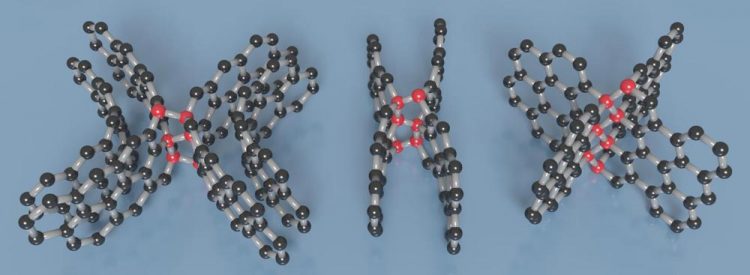New form of carbon that's hard as a rock, yet elastic, like rubber

This is a visualization of the different types of diamond-like linkages (red spheres) formed at curved surfaces or between the layers of graphene (black spheres) in this new type of compressed glassy carbon. Images are provided courtesy of Timothy Strobel
Carbon is an element of seemingly infinite possibilities. This is because the configuration of its electrons allows for numerous self-bonding combinations that give rise to a range of materials with varying properties. For example, transparent, superhard diamonds, and opaque graphite, which is used for both pencils and industrial lubricant, are comprised solely of carbon.
In this international collaboration between Yanshan University and Carnegie — which included Carnegie's Zhisheng Zhao, Timothy Strobel, Yoshio Kono, Jinfu Shu, Ho-kwang “Dave” Mao, Yingwei Fei, and Guoyin Shen — scientists pressurized and heated a structurally disordered form of carbon called glassy carbon. The glassy carbon starting material was brought to about 250,000 times normal atmospheric pressure and heated to approximately 1,800 degrees Fahrenheit to create the new strong and elastic carbon. Their findings are published by Science Advances.
Scientists had previously tried subjecting glassy carbon to high pressures at both room temperature (referred to as cold compression) and extremely high temperatures. But the so-called cold-synthesized material could not maintain its structure when brought back to ambient pressure, and under the extremely hot conditions, nanocrystalline diamonds were formed.
The newly created carbon is comprised of both graphite-like and diamond-like bonding motifs, which gives rise to the unique combination of properties. Under the high-pressure synthesis conditions, disordered layers within the glassy carbon buckle, merge, and connect in various ways. This process creates an overall structure that lacks a long-range spatial order, but has a short-range spatial organization on the nanometer scale.
“Light materials with high strength and robust elasticity like this are very desirable for applications where weight savings are of the utmost importance, even more than material cost,” explained Zhisheng Zhao a former Carnegie fellow, who is now a Yanshan University professor. “What's more, we believe that this synthesis method could be honed to create other extraordinary forms of carbon and entirely different classes of materials.”
###
The other members of the team are: Meng Hu, Julong He, Wentao Hu, Dongli Yu, Hao Sun, Lingyu Liu, Zihe Li, Mengdong Ma, Jian Yu Huang, Zhongyuan Liu, Bo Xu, Yongjun Tian of the State Key Laboratory of Metastable Materials Science and Technology; Yanbin Wang of the University of Chicago; and Stephen J. Juhl of Penn State University.
This work was supported by the National Natural Science Foundation of China, a grant for Distinguished Young Scholars of Hebei Province of China, the Postgraduate Innovation Project of Hebei Province of China, the Defense Advanced Research Projects Agency, EFree — funded by the U.S. Department of Energy (DOE), Office of Science, and the NSF. HPCAT is supported by DOE-NNSA and DOE-BES with partial instrument support from the NSF. APS. is supported by DOE-BES.
The Carnegie Institution for Science is a private, nonprofit organization headquartered in Washington, D.C., with six research departments throughout the U.S. Since its founding in 1902, the Carnegie Institution has been a pioneering force in basic scientific research. Carnegie scientists are leaders in plant biology, developmental biology, astronomy, materials science, global ecology, and Earth and planetary science.
Media Contact
All latest news from the category: Materials Sciences
Materials management deals with the research, development, manufacturing and processing of raw and industrial materials. Key aspects here are biological and medical issues, which play an increasingly important role in this field.
innovations-report offers in-depth articles related to the development and application of materials and the structure and properties of new materials.
Newest articles

First-of-its-kind study uses remote sensing to monitor plastic debris in rivers and lakes
Remote sensing creates a cost-effective solution to monitoring plastic pollution. A first-of-its-kind study from researchers at the University of Minnesota Twin Cities shows how remote sensing can help monitor and…

Laser-based artificial neuron mimics nerve cell functions at lightning speed
With a processing speed a billion times faster than nature, chip-based laser neuron could help advance AI tasks such as pattern recognition and sequence prediction. Researchers have developed a laser-based…

Optimising the processing of plastic waste
Just one look in the yellow bin reveals a colourful jumble of different types of plastic. However, the purer and more uniform plastic waste is, the easier it is to…



